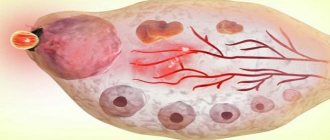Discharge in women plays a role, changing at different stages of the menstrual cycle under the influence of hormones. We know that during the release of the female cell, cervical mucus is observed, which resembles the color and consistency of egg white. But why thrush can appear after ovulation, and this phenomenon is quite common, let’s try to figure it out in our article.
Common reasons
The causes of fungal inflammation are the excessive proliferation of the opportunistic fungus Candida albicans, or Candida. These microorganisms are representatives of yeast-like flora. They are found on the healthy vaginal mucosa in small quantities. The reproduction of the conditional pathogen is controlled by lactic acid flora, lacto and bifidobacteria.
Under the aggressive influence of a number of drugs, the friendly lactic acid flora dies. Dysbacteriosis forms on the mucous membranes of hollow organs. It is expressed in a reduction in the number of lacto and bifido microorganisms and an increase in the colony of opportunistic flora. This is how a passive pathogen becomes active, causes inflammation and forms a curdled discharge.
Note: dysbacteriosis occurs on the mucous membranes of various organs. Therefore, if curdled vaginal discharge appears, we can confidently speak about the presence of dysbacteriosis in the intestinal cavity, stomach and oral cavity. Therefore, vaginal thrush may be accompanied by nausea, loose stools, and painful flatulence.
Excessive proliferation of yeast-like fungus, uncontrolled by healthy flora, leads to an increase in fungal colonies. They become visible to the naked eye. A woman develops a white discharge that is sticky to the touch.
Secretions of yeast-like fungi are toxic to mucosal cells. They cause redness, inflammation, itching, swelling and soreness in the vaginal and perineal area. There is a need to treat inflammation and restore vaginal flora.
Warning
Prevention of thrush is based on a healthy lifestyle. First of all, this means playing sports with feasible physical activity, which will not allow the body to stagnate.
Eating a balanced diet will also help prevent thrush. On the one hand, exhausting diets, and on the other, excessive nutrition negatively affect hormonal levels,3 which contributes to the development of Candida fungus.
Hormonal contraceptive pills or other medications can also have a negative effect on a woman’s hormonal state. Therefore, any hormonal medications should be taken only as prescribed by a doctor and if absolutely necessary.
Bad habits - smoking and drinking alcoholic beverages contribute to the development of fungal infections.
Prevention of the disease requires for personal hygiene procedures to use not simple cosmetics, but those specially designed for intimate hygiene.
And of course, underwear should consist of natural fibers that do not cause skin irritation and do not contribute to the growth of fungus.
Disease or normal
Vaginal candidiasis tends to recur. It returns when immunity decreases - during colds, after vaccination, in women - during pregnancy. The appearance of thrush during ovulation is often regarded as one of the symptoms of conception. Why?
The onset of pregnancy in a woman is accompanied by a physiological (meaning normal) decrease in immunity. This is due to the implantation of a fertilized egg into the uterine mucosa. In order for the mother’s body to accept a foreign body, hormonal reactions reduce overall immunity. This leads to a recurrence of latent infections, their obvious manifestation, by which conception can be judged.
Note: the most complete immunosuppressive effect is manifested inside the uterus and vagina. The immunity of other tissues decreases less noticeably.
The appearance of cheesy discharge after ovulation and fertilization is not normal. Such a “signal” indicates the presence of a latent infection in the body, in which the amount of candida flora slightly exceeds the norm, without the formation of cheesy discharge. With a decrease in immunity, sluggish candidiasis becomes more active and takes on a pronounced form.
With normal vaginal flora, fertilization is not accompanied by the proliferation of candida, the appearance of discharge and itching.
Disease prevention
In order to eliminate the possibility of developing a fungal disease after ovulation occurs, it is recommended to adhere to the following measures:
- Consult a specialist if you are planning a pregnancy.
- Do not take antibiotics, and if this is unavoidable, then delay conception for 6 months after the end of treatment.
- Normalize your lifestyle and diet by eliminating sweet and spicy foods.
- Observe personal hygiene rules.
Many women believe that if symptoms of thrush appear after ovulation, it means that fertilization has occurred. Such statements are incorrect. Thrush only indicates that a malfunction has occurred in the body and requires immediate correction.
Treatment after ovulation
In order to stop recurrences of candidal infections and monthly vaginal discharge in the middle of the menstrual cycle, it is necessary to treat the infections and restore the composition of the vaginal flora. It is important to understand that treating thrush immediately after ovulation should be safe - since discharge can be a sign of pregnancy. How can you treat thrush during pregnancy? And what is necessary for effective treatment?
Treatment during pregnancy
The gestation period, especially the first weeks and months, is the most crucial. Taking toxic medications at this time leaves the most serious consequences. Therefore, at the beginning of pregnancy, you should refrain from any strong medications.
To treat thrush, which appears when the immune system is weakened, you can use only safe drugs. Soda baths and preparations that restore healthy bacterial flora - probiotics - will not cause harm and will effectively help against fungus.
Soda against candidiasis
Soda baths are made in warm water with the addition of soda. The concentration of soda solution for external use should be 1 tablespoon per 1 liter of water. Also, if thrush begins after ovulation, you can take soda orally and supplement the treatment with soda douching.
Internal intake of soda alkalizes the body in a complex manner. It limits the proliferation of candida in the stomach, intestines, their number in the blood and inside the vagina. For oral administration, dilute 1/2 spoon of soda in half a glass of hot water. Drink hot 1-2 times a day.
Douching limits the proliferation of candida directly in the area of inflammation. Therefore, its effectiveness is the highest among the proposed soda treatment options. For douching, dilute 1 tablespoon of soda in 1 liter of water.
Note: soda is a natural antimycotic, an antagonist of fungal infection. It alkalizes the acidic environment and makes it impossible for fungal microorganisms, which are active only in a highly acidic environment, to reproduce.
conclusions
The appearance of thrush immediately after ovulation is associated with a number of factors leading to disruption of the microflora and the formation of a favorable environment for the development of the disease. Thrush has nothing to do with pregnancy.
Thrush very often appears in the early stages of pregnancy in 30% of women, but it cannot be considered as a separate symptom, but only in conjunction with others.
A fungal infection does not directly affect ovulation, but gynecologists strongly recommend stopping planning and getting treatment. If the disease appeared after ovulation, when fertilization could theoretically have occurred, therapy is carried out with local antifungal drugs (allowed in the first trimester).
Probiotics to restore vaginal flora
Probiotics are drugs for the treatment of intestinal dysbiosis. Available in the form of tablets and capsules, which contain dried (lyopholized) lactic acid bacteria. When they enter the digestive tract, millions of bacteria colonize the stomach, oral cavity, large and small intestines. They acquire an active form, reproduce and replenish the composition of the friendly flora. Restoring the amount of healthy flora limits the proliferation of fungal infections.
Internal intake of probiotics allows you to restore the microflora of all hollow organs lined with mucus. With their help, dysbiosis of the intestines and vaginal flora is treated. To do this, they are not only taken orally, but also inserted into the vagina. This method allows you to cope with the manifestations of thrush within a few days.
Thrush as a sign of pregnancy?
Thrush alone should not be considered a sign of pregnancy. There must also be other symptoms of fertilization, which begin to appear about a week after ovulation. Before this period, conception does not manifest itself in any way.
All early manifestations of pregnancy at 8-14 DPO are described in more detail in this article.
Statistics(!) Thrush or vulvovaginal candidiasis is familiar to approximately 75% of all women. During pregnancy, these figures are even higher. That is why the disease is often associated with the onset of pregnancy and is its indirect sign.
Thrush should not be viewed only as a reaction to conception.
During pregnancy, its appearance is associated with hormonal changes in the body after embryo implantation. As a result of this restructuring:
- vaginal acidity changes;
- general immunity decreases (hence the foreign body - the embryo, will not be rejected by the mother's body).
Application of candles
The most effective and common products in this category are vaginal suppositories and suppositories. They act directly on the lesion itself, without affecting nearby organs and other systems.
Candles are used exclusively in a horizontal position. Doctors strongly recommend carrying out the procedure before going to bed at night, although it is not prohibited to do this at other times of the day. The patient will feel relief after just a few sessions.
The most important thing when using such medications is not to interrupt the treatment process, even if all signs of thrush are eliminated and ovulation proceeds smoothly. The average duration of therapy is two weeks.
The following are recognized as popular and effective candles today:
Is it possible to plan a pregnancy if women have thrush?
If you get sick while planning a pregnancy before ovulation, you need to stop planning and start treatment.
The main dangers in case of continuing open sexual life:
- There is a risk of developing chronic candidiasis (with exacerbations 4-6 times annually);
- You can infect your partner;
Thrush or vulvovaginal candidiasis. Candida fungi under a microscope
- Due to unpleasant sensations, a woman is depressed, and this is directly reflected in the functioning of all systems and organs, including reproductive;
- In order to easily carry and give birth to a healthy child, you need to get pregnant healthy.
The best solution is to move active planning to the next cycle.
Chronic thrush and planning
Women who want to become pregnant with chronic thrush should do the following::
- before starting planning, treat aggravated candidiasis. To do this, you need to undergo a powerful course of antifungal drugs (systemic + local) with supportive therapy (prescribed by a doctor individually, depending on the situation);
- if there is no exacerbation, then the doctor prescribes a milder preventive course of antimycotics (individually depending on the situation);
- then, observing all preventive measures (nutrition, hygiene, reducing stress and certain medications), you begin planning with the next menstrual cycle.
Advice(!) If chronic thrush worsens during certain seasons/months, postpone conceiving a child until a “healthier” time of year. After completing the course, you can have open sexual intercourse without protection in about a month (this time is enough for all the medicinal substances to leave the body).
Products that accompany the development of thrush
Women with chronic thrush, of course, already know about them. For those planning who are encountering candidiasis for the first time, they should first of all limit the consumption of foods that enhance the growth of fungi. Among them:
- sweets;
- flour products;
- starchy foods (potatoes, rice, corn, bananas);
- sweet fruits (grapes, fruit and berry juices);
- spicy, salty, pickled, smoked dishes and generally processed foods (the best alternative is pickled vegetables and fruits);
- tuna and mackerel (easily accumulate heavy metals);
- caffeine (no more than 1 cup in the morning);
- any alcohol.
So, if you are openly sexually active, without protection, and thrush begins, take a test or get tested. If the diagnosis is confirmed, use local antifungal agents approved in the first trimester.
If there has not been ovulation in this cycle yet, you can use any medications, including systemic ones (tablets). You can continue planning from the next cycle.
Does the appearance of thrush mean that you are 100% pregnant? Of course not, although pregnant women have a much higher incidence rate than non-pregnant women.
Make the right decision and be healthy. Good luck with your planning!
If you find an error, please select a piece of text and press Ctrl+Enter.
Thrush after ovulation worries 26% of women and 12% of girls. Sticky, cheesy discharge and vaginal itching are not normal. They indicate a hidden infection and the need for treatment. In this case, the appearance of leucorrhoea can be an indirect sign of pregnancy, so treatment should be safe.
White, cheesy discharge from a woman's vagina is called thrush or vaginal candidiasis. They are accompanied by unpleasant itching and slight pain. They can appear in girls and women for no apparent external reason.
Vaginal candidiasis is a manifestation of a fungal infection that causes inflammation of the vaginal mucosa. This disease is always a sign of decreased immunity. It can be acute or chronic, with periodic relapses during a cold, menstruation or after ovulation.










